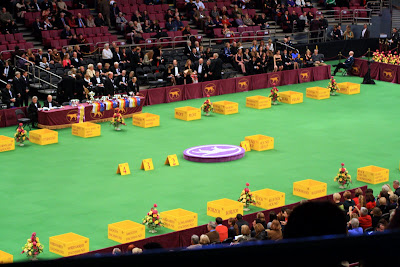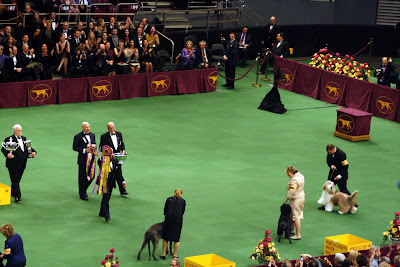What I mean by "talking puppy" is to talk enthusiastically to your dog. Sounds simple enough. I've told clients who have issues with their dog pulling on the leash that they should try praising their dog. They tell me they do that and the dog doesn't respond. Then you're not "talking puppy!"
When I first began training dogs, I struggled continually with this concept. I'm generally a very quiet person and quite shy. Basically...I don't like to make a fool out of myself in front of people! So when I was in training class and was told to talk enthusiastically to my dog Elsa, I whispered some "good girl's" to her, with no results.
It was when I began competing with her in Rally-Obedience when I found my true "voice." In Rally-Obedience, your dog must stay by your side while you walk through an obstacle course. The wonderful thing about the sport is that you can talk to your dog throughout the entire thing, however, you can't use treats. Now, if you didn't know before, you know now...I am very competitive.
So Elsa and I didn't compete in Rally-O just for fun, we competed to win! At our first show, I watched our competitors in the show ring and I watched their owners walk through the course like zombies...as if their dogs weren't even there, paying attention only to what they were doing, not to their dogs. And their dogs just weren't interested at all! So I wanted to make Elsa interested. I put all shyness aside, and I talked to her, A LOT. I told her she was beautiful, I told her she was wonderful...and she took in every single word! I made Elsa feel on top of the world! And she enthusiastically stayed by my side, rocked the course, and won a blue ribbon!
I took what I learned from that experience with the dogs that I walk. What a difference it made! No longer was I pulled along all day long, I had dogs that not only stayed by my side, but enjoyed staying by my side! They loved being told how wonderful they are...who wouldn't?!
 And in addition to telling them praise, you can also learn to get their attention with certain phrases. For example, whenever I'm about to bring my dogs for a walk, or throw a toy, or give them a treat...in an enthusiastic voice I ask them "are you ready!?" All of those things...a walk, toy, or treat are rewards. So now they here "are you ready!?" and they know they're getting a reward! We also play "up here!" I hold a treat up high and tell them "up here!" and they jump up to get the treat. It didn't take long to teach them what "up here!" means and they absolutely LOVE the game. So now, if I really need to get their attention, I'll enthusiastically say "are you ready!?" or "up here!" and it's a guarantee I'll get them to look my way.
And in addition to telling them praise, you can also learn to get their attention with certain phrases. For example, whenever I'm about to bring my dogs for a walk, or throw a toy, or give them a treat...in an enthusiastic voice I ask them "are you ready!?" All of those things...a walk, toy, or treat are rewards. So now they here "are you ready!?" and they know they're getting a reward! We also play "up here!" I hold a treat up high and tell them "up here!" and they jump up to get the treat. It didn't take long to teach them what "up here!" means and they absolutely LOVE the game. So now, if I really need to get their attention, I'll enthusiastically say "are you ready!?" or "up here!" and it's a guarantee I'll get them to look my way. Sounds easy enough, and I'm sure some of you are thinking "well I already talk puppy!" Try talking puppy to your dog when you're outside walking and you see another dog ahead of you. If you're dog ignores your talking and only wants to meet the other dog, you're not talking puppy!
You need to talk to that dog as if he's the greatest thing in the world! Make your voice higher pitched, loud, and as enthusiastically as possible. And you should practice. Yes, practice talking puppy. Your dog will love it. Start without distractions, wait until your pup is dozing or busy chewing a toy, and start telling him how wonderful he is as enthusiastically as you possibly can. No doubt you'll get a wiggly, happy pup bounding up to you to hear more! Then try the same thing when you let him outside to go to the bathroom, and then on a walk...increasing distractions as he learns.
And believe me, your dog will let you know whether or not you are properly talking puppy! It's not an easy as it sounds, but once you learn, it'll be one of your best tools in training your dog!
Good dog!


























